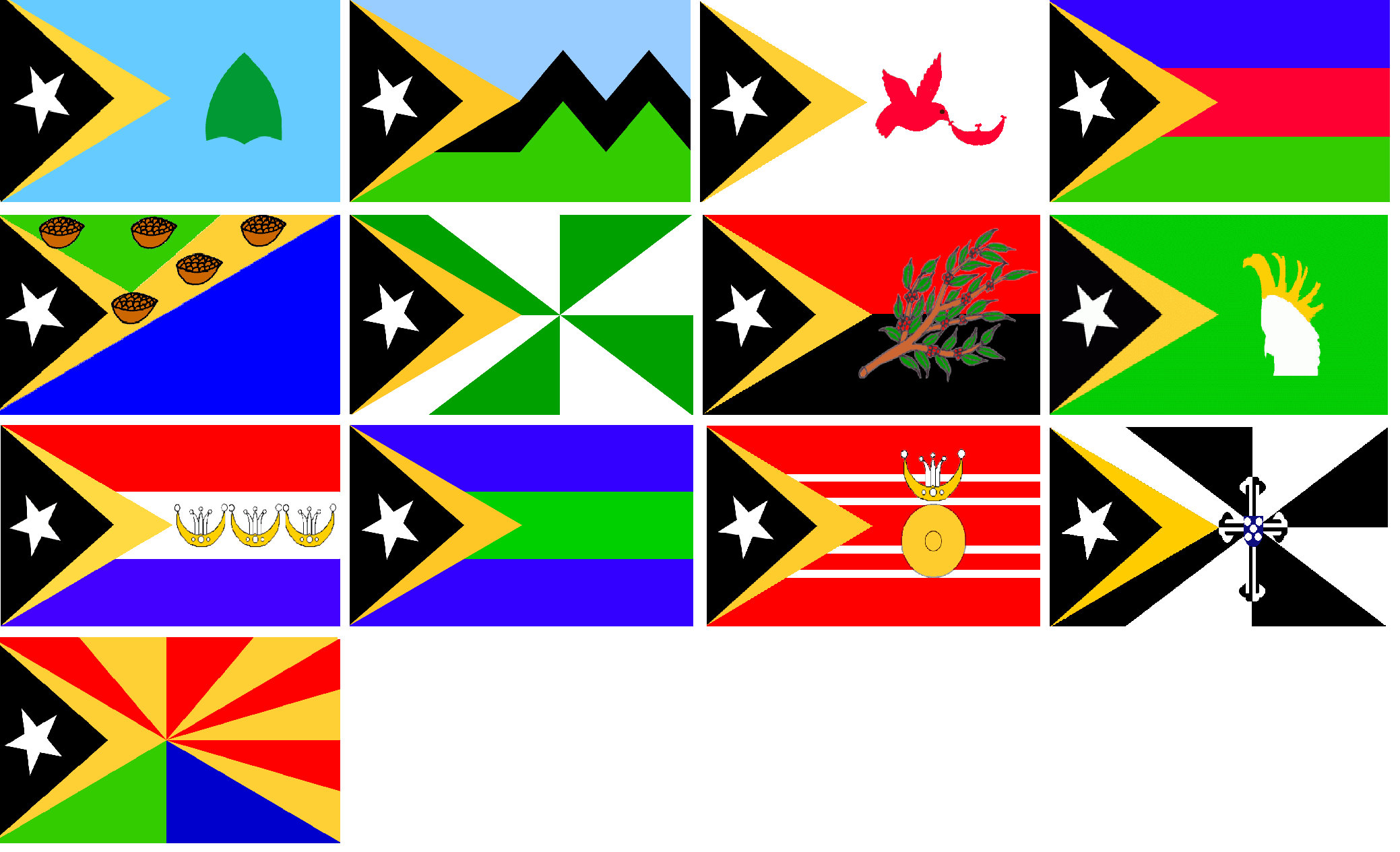 image by J.
Patrick Fischer, 10 January 2012
image by J.
Patrick Fischer, 10 January 2012
Last modified: 2015-10-23 by ian macdonald
Keywords: colonial flag | weaving |
Links: FOTW homepage |
search |
disclaimer and copyright |
write us |
mirrors
The current districts (distritos) are the same units as the Portuguese era municipalities (municípios or concelhos), both in name and territorial make up:
The Portuguese administration divided it into 13 municipalities and 64
communes (also called "postos").
António Martins, 09 July 1998
I don't know whether these remained operational and/or official in
1975-2000, nor, if so, under which name (districts or municipalities).
António Martins, 22 July 2001
On the right and the left wall of the East Timor national parliament
are hanging traditional weavings,
each with the name of one of the districts. Each district has such a weaving
on the left and the right, but there are not exactly the same, just similar.
So, not regional flags, but examples of traditional designs of each
district?…
J. Patrick Fischer, 08 August 2002
A set of flag images purporting to represent the "Districts of East Timor" is posted on Wikimedia commons at http://commons.wikimedia.org/wiki/Category:Flags_of_districts_of_East_Timor. These images were drawn by J. Patrick Fisher for internal use in FOTW and (although they were forwarded to the government in East Timor) have not been adopted to our knowledge by any of the districts.
I never saw my images in official use in TL and the districts are still not
changed into municipalities with their own elected administrations. The
administrators are still nominated by the central government, so I can not see
any local authority which could use "my" flags.
J. Patrick Fisher,
10 January 2012
I just heard it in the radio: the CNRT, meeting in Darwin, Australia, issued a first draft of the future administrative division of the future independent republic of Timor Lorosae. The 13 municipalities [districts] are maintained in principle, but the territory will be divided into 3 provinces (handled by the CNRT as economical planning regions), a northern province including Díli but excluding Atauro and Ocussi Ambeno, a Eastern province including Baucau and the eastern half of the territory and a southern province including the southern coast. The provinces would include:
So, in the future Republic of East Timor, if this plan is implemented, the following flags are to be expected:
I’ll not be surprised if both municipalities and
communes are to be changed in near future. I guess
the flags from the Portuguese era (unused in the
last 25 years) will not be revived.
António Martins, 23 October 1999
Well, they might. The majority of the Timorese are
in a state of nostalgia for everything Portuguese so
they just might dig up the old municipal flags, at least
to serve as basis for new ones. Anyway, the
CNRT proposed to the UN the
organization of local elections within one year, so these
flags would possibly be used only after that.
But everything is highly speculative here.
Jorge Candeias, 27 October 1999
The four parts [symbolized on the U.D.T. flag] of the territory are:
As far as I know, the Indonesian occupation didn’t change the limits of the territory (one might ask why…), all those three territories [Jaco, Ocussi-Ambeno and Ataúro] being considered by the Indonesian government as parts of “their” 27th province Timor Timur. This border line, by the way, was settled between Portugal and the Netherlands very early in the 20th cent., if I recall correctly by swapping the vassal-dom of several native kingdoms along the border area, previously the territorial claims were a mess of enclaves and exclaves.
It might be of interest to say that
Oecussi-Ambeno (a coastal enclave to the SW) is
one of the 13 districts, Ataúro/Kambing (an island some 20 km north of Dili)
is/was one of the communes of the Dili district,
and Jaco (a very small islet, probably uninhabited) is/was a part of the
Lautém district, Tutuala commune.
António Martins, 22 August 1999
 image by J.
Patrick Fischer, 10 January 2012
image by J.
Patrick Fischer, 10 January 2012
The image above represents a compendium of flag proposals for the districts of Timor Leste, drawn by J. Patrick Fischer and submitted to the Timor Leste government, although with no response. They were subsequently posted on the internet by Mr. Guterres, who provided them for Wikipedia, where they are now posted as flags of the districts (linked from https://en.wikipedia.org/wiki/Districts_of_East_Timor).
I never saw "my" images in official use in TL and the districts are still not changed into municipalities with
their own elected administrations. The administrators are still nominated by the central government, so I can not see any local authority which could use "my" flags.
J.
Patrick Fischer, 10 January 2012